Red fox
Common name: Red Fox
Scientific name: Vulpes vulpes
Other common name/s: European red fox, fox
Origin: Europe
Animal status
In Victoria, foxes are declared as established pest animals under the Catchment and Land Protection Act 1994 (CaLP Act).
Read more about the invasive animal classification.
 Populations
Populations
History of spread
Foxes were introduced to Australia for hunting purposes during the mid-1850s, with most releases being around Melbourne.
Only 20 years after their introduction, foxes were declared as a pest species in Victoria. Within 100 years, foxes had reached their current distribution on the Australian mainland. Today foxes occur over 75 per cent of Australia and their range is strongly linked with that of rabbits.
Distribution in Victoria
Foxes are found in all mainland states and territories. They have also been reported to occur in Tasmania.
In Victoria, foxes are found in a range of environments including urban areas, alpine heaths, rainforests, coasts and the Mallee. Victorian habitats are highly favourable for foxes.
Population density in Victoria
Fox densities are often higher in urban areas, than they are in rural areas, because resources including food, water and shelter are often plentiful. For example, there are as many as 16 foxes per km2 in Melbourne while in temperate agricultural areas, their densities are estimated to be around 4–8 per km².
Animal biology
Established Invasive Animals Best Practice Management video series
1. Fox Control in Victoria
Hi, I'm Lucy Reiger from the Established Invasive Animals Team here at Agriculture Victoria. Foxes are a highly destructive invasive species and pose a significant threat to livestock and native wildlife. This video will give an overview of foxes as an invasive species and explores common control methods landowners can use to help manage populations.
The European Red Fox was introduced to Australia in the mid 1800s for hunting purposes. However, populations quickly spread across the country closely following that of rabbits. Today, foxes are found throughout all states and territories except Tasmania.
Foxes breed once per year, commencing around June and July. Males mature at nine to ten months of age, and 85% of females breed in their first year. Foxes generally have three to five cubs per litter, which are typically born between August and September. Foxes also have relatively large home ranges and can travel up to 10 to 15 kilometres per night in search for food and don't always return to the same den.
Foxes are opportunistic predators and will eat a wide variety of foods, including small to medium size mammals, rodents, as well as carrion. Foxes are highly adaptive and can be found in both regional and urban areas with their highest densities being found where resources are most abundant. Foxes have a devastating impact on native wildlife across Australia, currently threatening 14 species of bird, 48 mammal species and 12 reptile species. In fact, almost any animal up to 5.5 kilograms in weight is at risk of fox predation.
The economic impact of foxes is estimated to be $227.5 million per year. Foxes are also a potential biosecurity risk and may be implicated in the spread of diseases such as rabies if it were to ever enter the country.
The first step to managing foxes on your property is to identify fox activity. Key signs of fox activity include tracks, dung or scats, fox dens, as well as animal carcasses or bite marks. The best thing to do is familiarise yourself with these key signs and to look out when monitoring your property.
Once you've identified fox activity, there's a range of control methods you can use to help manage their populations. The most common control method is baiting, which involves laying poison bait designed to target foxes. Other control methods available include Canid Pest Ejectors, as well as ground shooting, trapping, and fencing. It's important to note that none of these standalone techniques are a hundred percent effective on their own, which is why an integrated approach is most effective for managing foxes. We'll provide more information about each control method in other videos as part of this series.
Foxes are a widespread invasive species that threatens agriculture, the livestock industry, and the environment. It's important to select suitable control techniques for your property and business and to implement these in a strategic manner. You can find more information on the Agriculture Victoria website. Enjoy the series, we hope you found this helpful, and thanks for playing your part in managing Victoria's invasive pest animals.
Appearance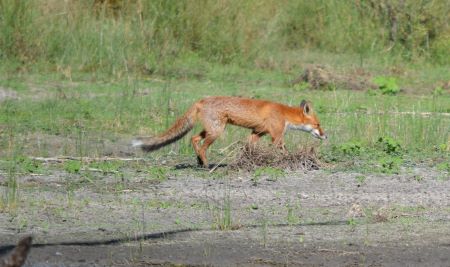
There are 21 different species of fox throughout the world, but in Australia only red foxes occur.
Red foxes have big ears, a bushy tail, and variable coat colours and patterns. They are usually reddish-brown above with a whitish/grey chin, chest and belly. They commonly have a distinct white tip on their tail, but sometimes it may be black or dark red. Foxes have a narrow chest and long legs, they also have long, high-set, semi-retractable claws making them excellent climbers and burrowers.
While their size can vary, males typically weigh 4 to 8 kg and females 4 to 6 kg.
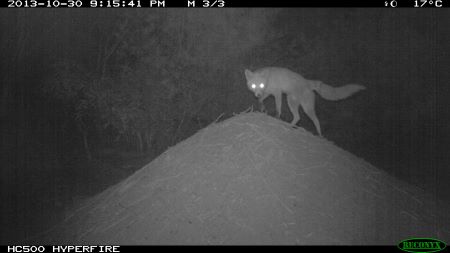 Behaviour
Behaviour
Foxes are mainly nocturnal (night-time) hunters, being most active from dusk until dawn. They also occupy well-defined home ranges that are marked with scents including urine, droppings and anal gland secretions. In addition, foxes display territorial behaviours such as confrontation (aggressive and non-aggressive) and vocalisations.
Foxes will travel outside their home range to access seasonally abundant food, such as lambing flocks or migratory bird breeding colonies.
Foxes may travel up to 10 to 15km per night but often rest in hides during the day. These hides include hollow logs or trees, enlarged rabbit burrows or dense undergrowth.
Foxes develop a strong social structure during the breeding season. These social groups typically consist of a dominant adult male (dog) and a dominant adult female (vixen), together with several subordinate vixens which are usually related. The dominant female typically produces a litter of cubs, and the subordinate females help rear them.
Foxes also cache (bury) food to eat later, which is a basic survival strategy. Caching usually involves placing the food in a small hole and covering it with soil or debris.
During lean times, when bad weather or injuries result in poor hunting success, foxes rely on this cached food for survival. Adult foxes and cubs will defend cached food and will move it to another location if disturbed by other foxes.
Foxes also exhibit surplus killing behaviour where they will kill more prey than they need at that moment in time.
Foxes have long, sharp teeth and very quick reflexes. They kill by inflicting multiple bites around the head and neck. Birds such as poultry may only have the head and neck eaten, large feathers are chewed off rather than plucked out. Relatively large prey such as lambs typically have their tail, ears and tongues eaten and often the chest cavity is opened to eat internal organs. If the skin around the neck is cut back many small holes may be evident as a result of fox kill. Lambs and calves sometimes have their tongues eaten by foxes and sheep or cows can have teats or vulvas chewed off.
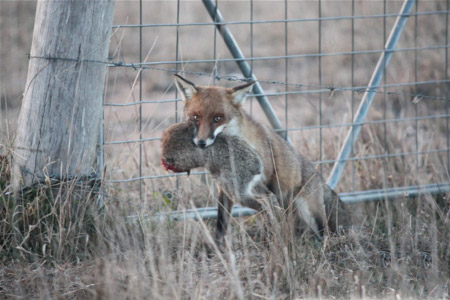 Diet
Diet
Foxes are opportunistic omnivores that eat a variety of meat, insects and plant materials.
Where present, rabbits make up the bulk of fox's diet. Other common food items include:
- carrion (domestic livestock and native fauna)
- house mice
- insects
- reptiles and amphibians
- birds
- grain
- vegetable matter (including crops)
- fruit crops such as grapes, apples and blackberries.
Primary predation by foxes on domestic livestock is common and those most susceptible include:
- poultry
- newborn lambs
- goat kids
- deer fawns
- domestic emu and ostrich chicks.
There have also been isolated instances predation of calves from difficult birthing.
A large portion of the fox's diet consists of introduced and native animals. Foxes mostly prey upon animals weighing between 35 to 5500 grams (sometimes referred to as critical-weight-range species).
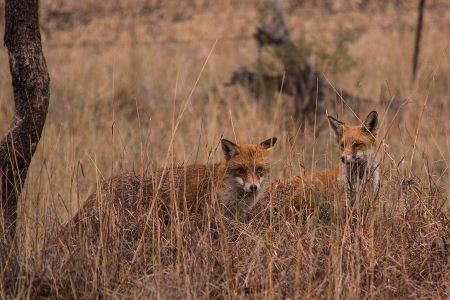 Preferred habitat
Preferred habitat
Fox populations are established in urban, suburban, agricultural and natural environments throughout Victoria. Foxes are often seen in urban areas, especially where they can shelter in parklands and reserves.
Outside urban areas, foxes are probably most abundant in fragmented agricultural landscapes that provide a range of habitats, food and cover.
Predators
Foxes have few natural predators in Australia, with most mortality occurring because of humans or drought. Fox cubs are vulnerable to birds of prey and dogs.
Diseases and parasites
Urban foxes have access to greater diversity and abundance of human food waste, and as a result, have a greater exposure and possible resistance to diseases that may infect their rural counterparts. Some of these diseases may also infect humans and domestic animals, including dogs. Mange and distemper are thought to be important causes of mortality in wild fox populations, but little is known about their role in regulating Australian fox populations.
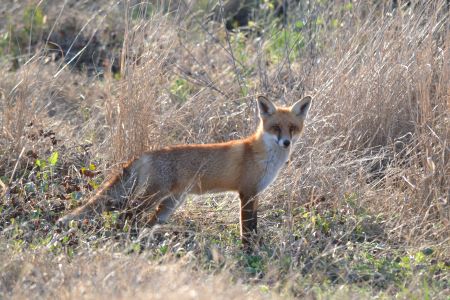 Reproduction
Reproduction
Foxes exhibit both monogamy and polygamy. Polygamy occurs where males mate with more than one female in the same range, or where the male mates with multiple vixens from separate ranges.
Vixens mate once a year and will accept males over a three-day period. Breeding is triggered by changing day length and food availability. In Australian, mating typically occurs over a 3-to-7-week period from mid-June to the end of July.
Fox litters vary from three to five cubs. Pregnancy lasts for 51 to 53 days, and cubs are born in dens early August to late September.
The cub's eyes begin to open after 8 to 14 days.
Cubs eat regurgitated meat at around 3 weeks and partly digested whole food items at around 4 weeks. Vixens cease lactating and wean cubs at 5 to 8 weeks.
Cubs emerge from the den at around 6 weeks, and by 8 to 10 weeks they abandon the den and live on the surface.
At 3 months, cubs hunt for small animals and gradually gain independence by January or February.
Although they may stay in their family groups, juvenile foxes become completely independent by March.
Dispersal from the natal area occurs from March onwards when juvenile foxes are 6 to 9 months old.
Young foxes are sexually mature by 9 to 10 months, with 85 per cent of young females breeding in the first year.
Dispersal
Young foxes typically disperse from their family unit at the beginning of autumn, which can result in a large floating population of young foxes looking for a place to live. Since the mortality of adult foxes is considerably high (50 to 60 per cent), there is a rapid and considerable change in territory occupancy from one year to another.
Dispersal of young foxes is an instinctive behaviour that occurs in all populations of foxes over varying distances. Dispersal distances are usually shorter where resources are abundant and greater where resources are scarce.
Males are more likely to leave the parent's territory than females, and to greater distances, with males moving on average about 68km and females about 14km. It is believed that the dog fox acts more aggressively towards his male offspring, eventually chasing them out of his territory. In many instances the young female foxes do not move far to a new territory, and some will remain in the parent's territory to help them raise next year's litter.
Impact
Impact on ecosystems and waterways
In Australia, the impact of foxes combined with habitat degradation is the most likely cause of 'at risk' native animal declines.
The environmental cost associated with foxes is significant, so any large-scale reduction in fox densities could generate significant environmental benefits.
Fox predation has been listed as a key threatening process under the Australian Endangered Species Protection Act 1992 and the Environment Protection and Biodiversity Conservation Act 1999. A key threatening process is that which threatens, or may threaten, the survival, abundance or evolutionary development of a native species or ecological communities.
Foxes are also considered to be a threat to at least 14 species of birds, 48 mammals, 12 reptiles and two amphibians. Listed as critically endangered are the:
- orange-bellied parrot
- spotted quail-thrush (from Mt Lofty Ranges)
- herald petrel
- Gilbert's potoroo
- western swamp tortoise.
Foxes are thought to have played a major part in the demise and extinction of many ground-dwelling native species in the last 130 years.
Almost any animal up to 5.5 kilograms in weight is at risk from foxes. A single fox is estimated to eat about 400 grams of food each night. Over a year, this equates to around 150 kilograms of food. As foxes may kill many animals in a night, yet only consume a small amount of each, this could amount to thousands of mammals, reptiles, birds and insects killed each year by a single fox.
The scats of foxes contain the remnants of fruit and berries from native and introduced species. Introduced plant species found in fox scats include:
- boxthorn (Lycium ferocissimum)
- sweet briar (Rubus rubiginosa)
- blackberry (Rubus frutiscosis).
Foxes disperse weed seeds in their dung. A seed takes 4 to 48 hours to pass through a fox's digestive system; they can be distributed over wide distances. It is also likely that seeds are dispersed attached to fox fur.
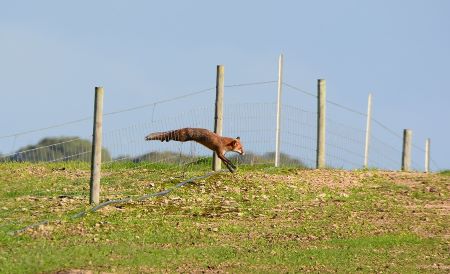 Economic impact
Economic impact
The economic impact of foxes in Australia has been estimated at around $227.5 million per annum. This includes: $17.5 million in sheep production losses $190 million in environmental impacts $16 million in management costs $4 million in research costs. These production losses are conservative in today's environment where lamb retail prices are higher. Primary fox predation may result in 4 to 30 per cent of lamb loss but their impact on agricultural production remains largely unquantified.
Total economic impact must also take into account the loss of potential genetic gain, the redirection of resources away from farm activities to control effort and reduced land values.
If rabies were to enter Australia the impacts would be devastating for native animals and domestic livestock. Rabies mostly affects members of the dog family, but can also be passed on to humans, livestock and native animals and foxes are known to be a major vector of rabies in many parts of the world.
Impact on social value and health
Foxes cause significant distress and hardship when they kill livestock such as poultry and lambs. Foxes also carry diseases that are transmissible to domestic dogs and human such as:
- sarcoptic mange
- hydatids
- leptospirosis.
 Urban foxes are a nuisance pest with behaviour including:
Urban foxes are a nuisance pest with behaviour including:
- harassing domestic animals
- eating pet food
- raiding rubbish bins
- defecating or digging in gardens
- chewing infrastructure such as garden hoses and irrigation systems.
Foxes may also prey on native and domesticated animals including:
- poultry
- rabbits
- guinea pigs
- aviary birds.
They can spread parasites and diseases such as mange and distemper to domestic animals and pets.
Management
Control measures used for foxes include:
- baiting
- harbour management where applicable
- fumigation
- shooting
- trapping
- exclusion fencing
- animal husbandry
- property hygiene.
The department recommends an integrated pest management approach that combines the use of all suitable control tools. They should also be implemented in a coordinated manner at a landscape scale.
For more information on integrated management strategies for foxes visit the Integrated fox control page.
Image credits
Figure 1: © Wayne Hillier
Figure 2: © Jason Wishart
Figure 4: © Daniel Schembri
Figure 5: © Bec Ballard
Figure 6: © Jason Wishart
Figure 8: © Dion Thompson
Figure 9: © Robyn Williams
References
- Campbell.S.J. 2020, Red fox viromes in urban and rural landscapes, Virus Evolution, 6 (2). Accessed online 13 November 2023.
- Cavallini, P. 1996. Variation in the social system of the red fox. Ethology, Ecology and Evolution 8, 323-342.
- Coman, B.J 1973, The Diet of Red Foxes (Vulpes vulpes) in Victoria, viewed 9th November 2009 at URL: http://www.publish.csiro.au/paper/ZO9730391.htm
- Bustamante, R.O., Simonetti, J.A. and Mella, J.E. (1992) Are foxes legitimate and efficient seed dispersers – a field test. ACTA Oecologica – International Journal of Ecology, 13: (2) 203-208
- DEWHA. 2008a. Background document for the threat abatement plan for predation by the European red fox. Department of the Environment, Water, Heritage and the Arts (DEWHA), Canberra.
- DEWHA 2008b. Threat abatement plan for predation by the European red fox, Department of the Environment, Water, Heritage and the Arts (DEWHA), Canberra.
- European red fox PestSmart Fact Sheet accessed on 10th February 2012
- Gong W., Sinden J., Braysher M. and Jones R. 2009 The economic impacts of vertebrate pests in Australia. Invasive Animals Cooperative Research Centre
- Graae, B.J., Pagh, S. and Bruun, H.H. (2004) An experimental evaluation of the Arctic fox (Alopex Lagopus) as a seed disperser. Arctic, Antarctic and Alpine Research, 36: (4) 468-473)
- Greentree, C., Saunders, G., McLeod, L. and Hone, L. (2000). Lamb predation and fox control in southeastern Australia. Journal of Applied Ecology 37, 935-943
- Henry, D.J. 1996. Red Fox; The Catlike Canine. Smithsonian Institute Press, Washinton,D.C., London
- Kinnear, J R, Sumner N.R., Onus, M.L., The red fox in Australia—an exotic predator turned biocontrol agent, Biological Conservation 108 (2002) 335–359
- Lloyd, H.G. (1980). Habitat requirements of the Red Fox. In The Red Fox, ed E.Zimen. Biogeographica, Vol 18, p 7. Dr W. Junk B.V. publishers, the Hague-Boston-London.
- Lugton, I.W. (1993) Fox predation on lambs. In 'Australian Sheep veterinary Society ' Australian Veterinary Association, Gold coast, pp 17-26
- Macdonald, D. W. (1976). Food caching by red foxes and some other carnivores. Zeitschrift fur Tierpsychologie 42, 170-185.
- Macdonald, D.W. (1979) 'Helpers' in fox society. Nature 282: 69–71. In managing vertebrate pests foxes
- McIlroy, J.C., Saunders, G.R., and Hinds, L. 2001. The reproductive performance of female red foxes, Vulpes vulpes, in central-western New South Wales during and after a drought. Canadian Journal of Zoology 79, 545-553
- McIntosh, D.L. (1963a) Reproduction and growth of the fox in the Canberra district.CSIRO Wildlife Research 8: 132–141.
- McLeod, R. (2004) Counting the Cost: Impact of Invasive Animals in Australia 2004. Cooperative Research Centre for Pest Animal Control. Canberra
- Reynolds, J. C. 2000 Fox Control in the Countryside. The Game Conservancy Trust,
- Rolls, E. (1969). They All Ran Wild. The Story of Pests on the Land in Australia. Angus & Robertson : Sydney.
- Saunders, G., Coman, B., Kinnear, J. and Braysher, M. 1995. Managing Vertebrate Pests: Foxes. Bureau of Resource Sciences, Australian Government Publishing Service, Canberra.
- Saunders, G., Kay, B. and McLeod, L. 1999. Caching of baits by foxes (Vulpes vulpes) on agricultural lands. Wildlife Research 26(3): 335-340.
- Short, J., Kinnear, J. E. And Robley, A. (2002). Surplus killing by introduced predators in Australia—evidence for ineffective anti-predator adaptations in native prey species? Biological Conservation 103 283-301
- Tembrock, G. (1963). Acoustic behaviour of mammals, In R.G. Busnel, ed., Acoustic behaviour of mammals. Amsterdam: Elsevier
- Saunders, Glen R., Matthew N. Gentle, and Christopher R. Dickman. (2010) “The impacts and management of foxes Vulpes vulpes in Australia.” Mammal Review 40.3 : 181-211.
- Carter, Andrew, Gary W. Luck, and Simon P. McDonald. (2012) "Ecology of the red fox (Vulpes vulpes) in an agricultural landscape. 2. Home range and movements." Australian Mammalogy 34.2 : 175-187.
- Marks, C.A. & Bloomfield, T. E. (1996) Distribution and density estimates for urban Foxes (Vulpes vulpes) in Melbourne: implications for rabies control. Wildlife Research 26, 763-75.
- Coman, B.J., Robinson, J. & Beaumont, C. (1991) Home range, dispersal and density of foxes (Vulpes vulpes L.) in central Victoria. Australian Wildlife Research18, 215-24.
- Saunders, G. and McLeod, L. (2007) Improving fox management strategies in Australia. Bureau of Rural Sciences, Canberra.
- Saunders, G., Coman, B., Kinnear, J. and Braysher, M. (1995) Managing Vertebrate Pests: Foxes. Bureau of Resource Sciences.